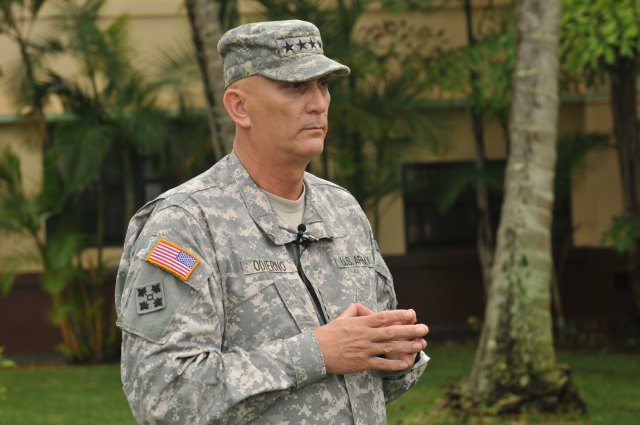The Army and NATO are watching “very carefully” the troop deployments and the exercises they’re doing in Russia, said Army Chief of Staff Gen. Ray Odierno.
“I think it’s important for us that we operate within the NATO framework to address these issues and we are doing that,” he told lawmakers in reply to a question regarding what the Army is doing about the situation in Ukraine, especially now that Russian troops are holding exercises near Estonia and other former Soviet republics.
Odierno, along with Secretary of the Army John M. McHugh testified at the House Appropriations Committee, Defense subcommittee budget hearing, today.
The Army is working several courses of action, Odierno continued, including providing supplies channeled through NATO or in a bilateral fashion.
“We’re conducting assessments of types of things we could do and we’re providing those to the joint staff for analysis,” he said.
While any decision to execute comes from the commander in chief, the Army must be prepared for any contingency, Odierno emphasized.
“Our NATO allies are concerned about what they’re seeing here, especially those in Eastern Europe,” he said.
Asked if the Army could move up some of its training exercises with Eastern European leaders, Odierno responded:
The Army has a “robust exercise program” that goes on throughout Europe that could be utilized to do many things. He added, “I think we’re taking a very hard look at that as we look at the exercises we have planned.”
Only last year the Army participated in Exercise Rapid Trident in Ukraine. During that exercise, armies from 17 nations participated. Members of the National Guard trained alongside Soldiers from the active component.
Also last year, Soldiers participated in Exercise Saber Strike, which took place in Lithuania, Latvia and Estonia. Fourteen nations participated.
“We partnered with numerous nations, improving our partner capacity and ability to command and control, enhancing our overall interoperability,” Col. Frederick Jessen, U.S. Army Europe’s contingency command post officer in charge said following the exercise last year, which he termed an “extreme success.”
Estonia, Latvia and Lithuania are members of NATO and the U.S. is bound by treaty to defend them.
Asked what force the U.S. has that could respond if asked to do so by the president, Odierno replied that 1st Brigade, 1st Cavalry Division, out of Fort Hood, Texas, is part of a NATO response force. “They’re supposed to conduct training exercises in Europe with NATO over the next several months.”
Also, he said some Soldiers assigned to Europe are now deployed to Afghanistan. The Army could deploy Soldiers to Europe from installations throughout the U.S. and elsewhere “depending on what we’re asked to do.”
Those troops could respond militarily or as part of a humanitarian mission as part of a joint force or as part of NATO forces, he said.
While Odierno said it’s not up to him to execute that deployment, it’s his duty to “ensure we’re ready if asked.”
As if Ukraine and surrounding areas were not enough, Odierno said he also has his plate full with possibilities for additional problems in the Middle East, where sectarian unrest is present, to ungoverned territories in the Middle East and Africa that are possible breeding grounds for terrorists, to the Korean peninsula and elsewhere.
And, while there are known trouble spots in the world, Odierno said it’s a challenge to predict where the next one will be. For instance, he asked, who could have imagined the problems in Ukraine a year ago?
As events in the world become less predictable and more chaotic, the Army is in the midst of a drawdown and facing the dire consequences to readiness that a sequester returning in 2016 would bring, McHugh and Odierno told lawmakers in myriad ways.
Lawmakers then asked how much lower manpower levels could be reduced.
Odierno said the lowest the active component could go to meet the Defense Strategic Guidance was around 450,000, maybe 440,000, a level he termed “the floor.”
But if sequestration comes back in 2016, he said that would result in the active force dropping to 420,000.
At that level Ordierno said, “I believe we will not be able to meet our mission. I believe it puts into question our ability to properly deter and even properly conduct one long, multi-phased campaign.”
McHugh said there was some low-hanging fruit that lawmakers could pick if they wanted an easy way to save costs, namely instituting another round a base realignment and closure.
“We need your authorization for BRAC,” he said. That’s the “best way to provide savings.”
The savings, he said, would come from closing unoccupied facilities that still have to be maintained at great expense. He estimated that a new BRAC round could save the Army $1 billion after a seven-year implementation period.
“That’s a hand-grenade estimate,” he said, explaining the Army is prohibited by the National Defense Authorization Act from doing that type of analysis, so it’s his “most reasonable” assessment.










